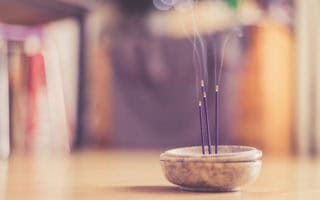
Joss sticks in smoking bowl are smoking and smelling, home, feng shui; Copy space;
To a lot of people, the idea of burning incense in a home seems like kind of an uncommon practice. It’s a cultural practice in some societies. However, in many western societies, it’s often something that people see as a nuisance. Residual odors can get into everything, like your clothes and household objects.
What we’re learning, though, is that the pervasive impact of burning incense is more than just a set of smells.
As we learn more about how combustion affects our indoor air, many of us will not want to burn anything inside our homes, including incense. Many will also look into getting a modern air purifier to help cycle out contaminants, but we’ll get to that.
Basically, burning incense in a closed space is in some ways, similar to smoking a cigarette. The chemicals in most types of incense will typically cause less harm than those in cigarettes. There’s still the same combustion process, though. Burning releases smoke, and that’s where the problem lies.
Incense Burning: Clinical Analysis
Take this scientific paper that looked at the effect of burning incense in a person’s home.
The academic writers describe a particular case where an elderly woman is having respiratory problems. She also has a history of COPD, as well as a dependency on oxygen.
What clinical observers found was that burning incense in her home was having a negative impact on her health.
“Our patient was an 87-year-old woman with (a) history of asthma and COPD, on oxygen therapy, who presented with unexplained shortness of breath,” wrote the lead author, Gomeo Lam.
This is just one of many research articles showing the negative effects of burning incense and how detrimental this is to one’s health.
Electric Incense Burning: An Alternative Option
In the paper, the writers talk about a change of lifestyle. The woman was introduced to electric incense burners. Experts recommended she use them instead of traditional incense.
Electric incense burners heat the incense and release the aroma without actual smoke. That can be much better for your lungs than traditional burning. That’s because burning incense releases something called PM 2.5. PM 2.5 is a term for small particles that can travel through the air and get deeply embedded in the lungs. They can get into the bloodstream. These particles can cause different kinds of respiratory conditions and symptoms. That includes ear, nose and throat irritation, coughing, wheezing or fatigue.
In addition, incense burning can result in the release of certain chemicals called Volatile Organic Compounds or VOCs. That’s another thing to watch with regard to the quality of the air inside a home. This National Library of Medicine article goes into more detail about the risks of VOCs with incense burning.
Wildfires and Risk
One example is wildfire smoke, which will typically release significant amounts of PM 2.5. We’ve written about this, as people research the effect of regional wildfires, where smoke travels long distances and affects many of our communities.
The bottom line is that the materials in incense, burned traditionally, also release many of these small particles.
“People who burn incense may not realize that family members, including children, who are exposed to secondhand smoke, face health consequences,” says allergist Mary Lee-Wong, as quoted in the above academic article. “Similar to tobacco smoke, thirdhand incense smoke may linger in furniture, clothing, and other articles, dissipating for months afterward.”
So you can stop burning incense in your house, but what do you do if you have residual contamination from things that came in from outside? Or what if you have people who are allergic to pets or mold, or various types of natural allergens?
Indoor Air Quality and Air Purifiers
One good solution is easy. You can use an air purifier to trap and remove particles from the air inside your home.
A modern HEPA filter can get rid of a lot of this nasty stuff, and leave your air cleaner and more breathable. A standard HEPA filter traps over 99.97% of particles down to .3 microns, and a stronger super HEPA deals with down to .1 microns, effective at a rate of 99.99%.
If you’re worried about the quality of your indoor air, you can first use an air monitor to see what’s present, and then get the right kind of air purifier to remove it.
Some of these appliances work better on harsh chemicals, and some are better for things like pet dander and dust mites. Some are better for PM 2.5 that results from combustion. For incense, take a look at the AirPura V400 or V700 models, or the Austin Air Healthmate Plus. The IDEAL PRO AP80 is another model that is useful here, with not only a HEPA filter, but an Activated Carbon Filter which is important for chemicals.
You can also choose from traditional filter technologies, or models that heat particles to destroy them – and you can get extra features, like the release of beneficial bacteria into your indoor air to help balance the biome inside of your living space.
US Air Purifiers LLC can help you to get the right solution for your home or business space. We know how these models stack up, with warranty details, features, air changes per hour, and more. Get the confidence to make the right purchase and improve your health in your home!